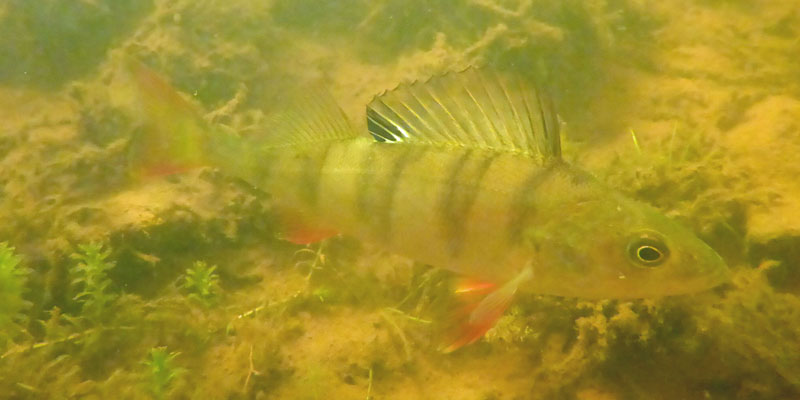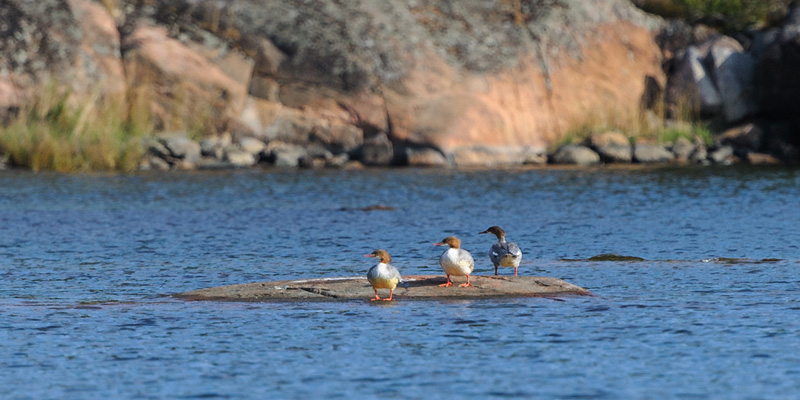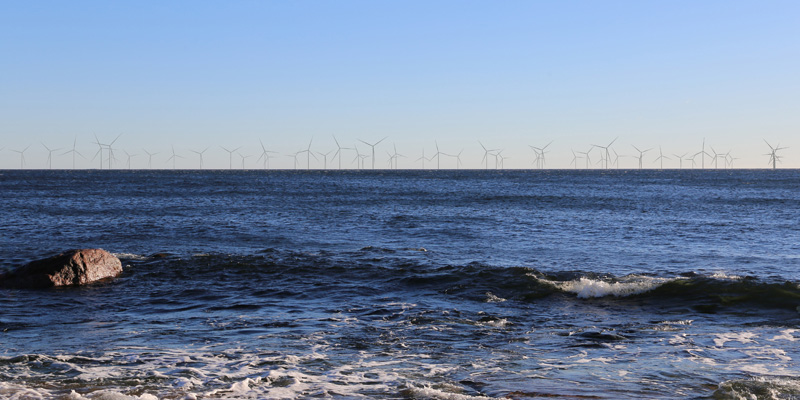Impacts of offshore wind power
The environmental impacts of an offshore wind farm vary significantly, depending in particular on the location of the project. The environmental impacts can be negative and positive: construction changes the environment, but it can also create favourable conditions. For example, an offshore wind farm may affect the migration routes of some species, but create resting and feeding places for others. It can cause some species to leave the areas, while simultaneously creating favourable conditions for others.
The following section provides a general description of the most common environmental impacts. Not all of these impacts are realised as such in any project.
Environmental impacts are assessed in the EIA procedure and in conjunction with zoning
The environmental impacts of offshore wind power plants and the measures taken to minimise them are assessed when zoning the area, in connection with the water permit process, and in the statutory EIA procedure.
Environmental impacts are generally assessed for offshore wind turbines, the electricity transmission cable laid on the seabed, and the substation located on the coast. Impacts are assessed for the entire life cycle, which means construction, operation, decommissioning and dismantling of the turbines.
Use of the area
An offshore wind farm affects recreational use in the water area mainly during the construction period, when access to the area is restricted for safety reasons. It is not usually necessary to restrict fishing or recreational use during operation. However, trawling by professional fishermen will be restricted above a submarine cable. During freezing conditions in the winter, there is reason to be careful of falling ice falling.
Shipping needs are already taken into account when selecting areas for development. The impacts of an offshore wind power project on shipping are also investigated in the EIA and zoning phases. Wind turbines are marked in nautical maps and geospatial data.
Water quality
The impacts of offshore wind turbines on water bodies are determined using methods such as modelling of water flows. During the operation of a wind farm, the state of the environment is monitored according to the provisions outlined in the water permit.
Earthmoving operations, dredging and levelling of the seabed during construction cause temporary and local turbidity in the water. In addition to building foundations, soil mass disposal and laying the submarine cable on the seabed may cause turbidity, especially in deeper water layers.
If dredging is required in shipping lanes, this process may release harmful substances accumulated over the years.
The impacts on water quality during construction depend on the working methods used, seabed currents, and the weather conditions. These impacts are usually short-term, with fauna returning to favourable areas after construction ends. The foundations of a wind power plant may also provide favourable living conditions for fauna.
According to research data, very little microplastic is released into the sea from offshore wind farms. The blades of wind turbines are usually made of composite materials and are well protected against wear and tear from the sun, wind and rain. According to the Swedish Naturskyddsföreningen, the country’s wind farms release a total of about 0.6 tons of microplastics per year.
- More information about microplastics in wind turbines: Svensk Vindenergi, Fakta om vinkraft (in Swedish)(svenskvindenergi.org), Wind power and microplastics (in Finnish), Suomen Tuulivoimayhdistys (tuulivoimayhdistys.fi)
Underwater nature
The greatest numbers of underwater flora and fauna are found in shallow waters, because that is where the most light is. In many offshore wind projects, it is possible to avoid building in the shallowest or deepest areas where biodiversity would suffer.
The construction of an offshore wind farm changes the local seabed structures because large soil masses are moved in the area. On the other hand, the wind turbine foundations form artificial “reefs” and provide certain species with sheltered areas protected from boating.

The construction of offshore wind turbines may disturb fish and their spawning in that area during the construction period. Local fish stocks are generally estimated to return to normal after a temporary disturbance has ended.
Construction interferes with fishing and movement in the area on a temporary basis. The location of the submarine cable may cause local restrictions on the placement of fishing traps or some forms of fishing.
Currents, water flows
Water currents and flows change to a certain extent near offshore wind turbines. However, the turbines are located quite far apart, so the impacts on currents or waves are local.
Climate
An offshore wind farm produces large amounts of zero-emission electricity that can replace energy produced with fossil fuels. This significantly reduces emissions. Offshore wind turbines play a very important role in helping Finland reach its carbon neutrality targets.
Turbine construction consumes natural resources and causes some emissions. Traffic associated with construction and maintenance also produces some emissions. However, these impacts remain relatively minor in relation to the benefits of zero-emission electricity produced by the turbines.
Use of natural resources
Wind turbines have a service life of 25–35 years, depending on the equipment manufacturer.
Most of the raw materials used in wind turbines (up to 80–90% in some projects) can be recycled. Leading wind turbine manufacturers already offer fully recyclable structures. The recycling rate of metal components (steel, copper, aluminium, lead) in the turbines is high, almost 100%.
Birds
Bird migration routes or resting areas may be located in the area of an offshore wind farm. The offshore wind farms planned by Metsähallitus are situated more than 10 km from the coast. The open sea location alleviates the impacts on birds, as bird territories and migration routes are usually close to the coastline.

Based on experiences from the Tahkoluoto offshore wind farm, birds in Finland do not usually collide with wind turbine blades. However, the turbines may affect migration routes and resting areas. Maintenance activities, sounds or shadow flicker in the wind farm area may also interfere with, for example, nesting in the islands near the turbine site if these are found within its sphere of influence.
According to research involving the main migration route along the Bothnian Bay coast, very few birds collide with wind turbines – even during the migration period. Birds clearly have the ability to detect, circumvent and avoid turbines. White-tailed eagles tend to mainly stay closer to the coast.
Nature sites and protected areas
Any nature reserves or valuable nature sites in the area are taken into account when planning the location of the offshore wind farm.
Any wrecks and other sites to be preserved in the area under consideration are surveyed in marine archaeological inventories.
Impacts on people’s living conditions
People experience offshore wind farms and habitat changes in different ways. Tourists may consider them negative or interesting phenomena, for example, due to landscape impacts.
Noise
In the open sea area, water carries the sound of an offshore wind turbine a few kilometres. This distance is also affected by other sea sounds: wind and waves. The sound level about one kilometre from the farm is 40 dB. During production, the sound volume is around 50 dB, which is similar to the sound level in an office environment.
The increase in construction-related and operational maintenance traffic may also increase noise and local disturbance. The construction of an offshore wind farm usually takes approximately 2–3 years.
In 2020, the Finnish Institute of Occupational Health and VTT & partners studied the health impacts of wind turbine infrastructure noise. The two-year study did not provide evidence of health impacts.
- Read more about the sudy (vttresearch.com)
Shadow flicker
Wind turbines can cause short-term shadow flicker – for a few minutes a day – if a person looks at the turbine from a place where they see the blade moving in front of the sun. This impact stops a few kilometres from the turbine.
The effects of shadow flicker are modelled when planning a wind farm, and then assessed in relation to the limit values applied in Finland in the EIA procedure.
Landscape

The further an offshore wind farm is from the coast, the less visible it is in the landscape. The distant landscape starts at 10 kilometres, and the human eye can no longer distinguish structures at that distance.
The visibility of wind turbines also depends on how the viewer is positioned in relation to the nearest obstruction, which may be, for example, an island. An obstruction to visibility can easily hide a turbine located quite nearby, while a field, lake, open mire, etc. makes them visible far into the distance. Humidity also limits visibility.
The aviation obstruction and navigation lights of turbines can be seen in the dark.
Offshore wind turbine technology is developing rapidly. The tower can be approximately 200 metres high and the turbine blades can rotate at a height of 200–300 metres. The nacelle – a unit that is larger than a bus – is situated at a height of approximately 150–180 metres. Turbines are usually located at least one kilometre apart in the project area.
On the mainland, the visible part of a wind farm is the substation needed for the electricity transmission cable and the transmission connection from the substation onward, so the locations and routes for these structures are carefully planned and adapted based on the residents’ views.
Traffic
Construction of an offshore wind farm increases traffic both on land and at sea. Depending on the project location, it may be necessary to reinforce the road network and ports and pay more attention to traffic safety.
Economic impacts
Offshore wind farms are billion-euro investments that last for decades. They strengthen the regional economy, both directly and indirectly. Direct impacts include local procurement during construction, such as accommodation and meal services. The indirect impacts of the investment extend, for example, to other industries. The supply of zero-emission energy also creates growth opportunities for other industries, such as the production of clean hydrogen.
The impacts on the regional economy are greatest during the construction period. The positive economic impacts during operation consist of jobs for operational staff and property tax paid to the local municipality.
State area, municipal real estate tax
Property tax received by the municipality depends on the construction costs of the turbines and the property tax level determined by the municipality. The annual real estate tax income brought by one offshore wind turbine can amount to 70,000 euros. Thus, the annual real estate tax income for the municipality of a large offshore wind farm can be several million euros.
Increased economic activity also creates other regional cash flows, both during construction and after production starts. Employment opportunities include planning, related construction of the wind farm infrastructure, transportation, wind turbine installation work, and accommodation and catering services.